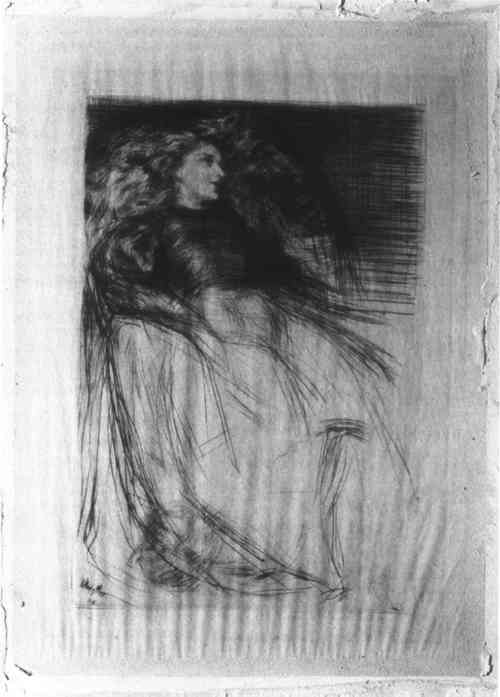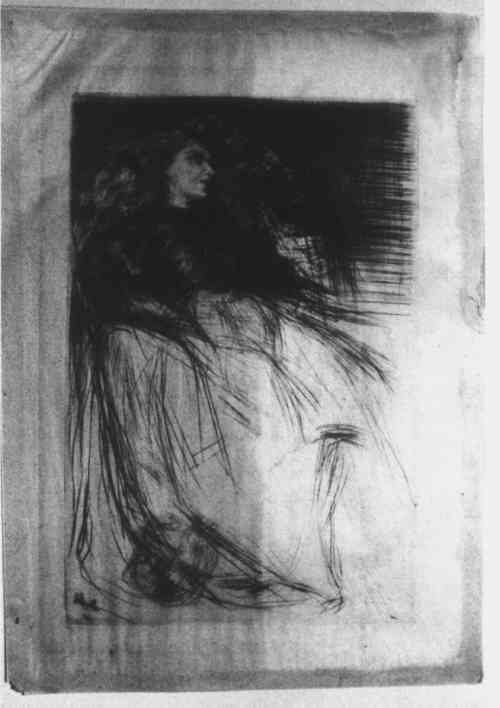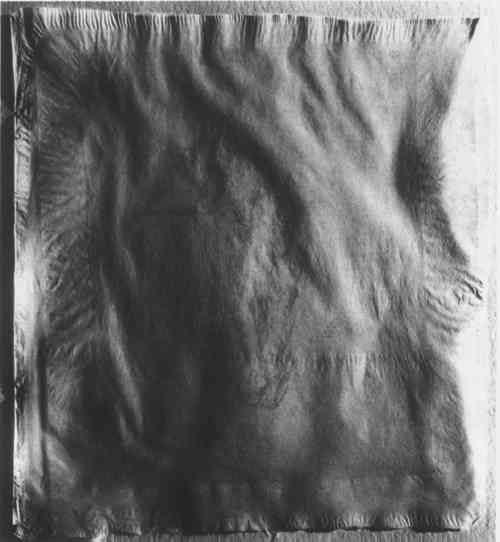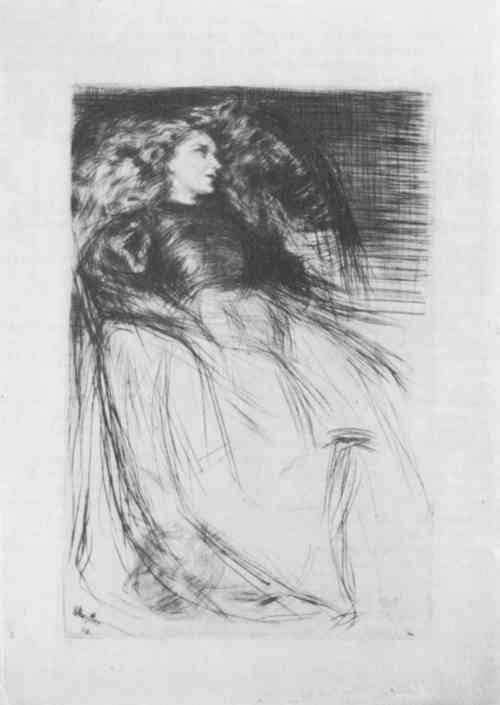THE TREATMENT OF THREE PRINTS BY WHISTLER ON FINE JAPANESE TISSUEShelley Fletcher, & Judith Walsh
ABSTRACT—Three prints by Whistler on exceptionally fine Japanese tissues were removed from pulp-board mounts, treated with enzymes and dried using “friction drying.” The authors report, in detail, on the products and methods used in enzyme removal of the starch adhesive residues. They discuss their procedure for successful drying of troublesome Japanese tissues. THREE PRINTS by James Abbott McNeil Whistler from the collections of the National Gallery of Art in Washington, DC were recently treated in the Paper Conservation laboratory there. These three prints, Weary (drypoint B14,309), Nude Model, Backview (color lithograph, Rosenwald Collection, B14,010) and Nude Model, Standing (color lithograph, Rosenwald Collection, B14,015), were printed on exceptionally fine Japanese tissue. All edges of each print had been affixed with starch paste to medium-weight, wood-pulp cardboards faced with white paper which showed a surface pH of 4.5.1 It appears that the prints were mounted while wet. During drying, the variation in the amount of shrinkage in each direction resulted in many vertical draws in the sheet. The draws were visually distracting and were endangering the print (see Figure 1). The poor quality of the board and the tension in the sheet made treatment necessary.
1 TreatmentWEARY was the first of the Whistler prints to be treated: its tissue support was the least fragile of the three. Ruled cuts with a fresh scalpel blade were made into the cardboard around the print approximately one-quarter inch from the tissue. By inserting a micro-spatula and later a thin bone folder under the paper facing of the board, the scored portion of the paper facing bearing the print was completely removed from the board. With the print face down on a clean blotter, the paper facing was carefully torn away from the reverse of the print. Some of the remnants of the facing paper and adhesive were removed from the edges with local applications of ethanol and water. The print was then floated on deionized water to relax the draws and release the residual bits of paper and adhesive. Prior to its removal from the cardboard, the print appeared to have been badly light-struck. However, most of the discoloration noted had occurred on the paper
Upon removal from the water bath the print was drained and partially air dried. It was then placed between felts and under light weights for two days. The paper dried with many tiny puckers overall, and when removed from the felts and allowed to relax, many large cockles appeared across the corners. These were attributed to adhesive residues around the edges of the tissue; they were quite distracting. 2 Enzyme Removal of Adhesive ResidueIN ORDER to determine the nature of the adhesive residues, individual paper fiber samples of the edge and interior were taken from the reverse of the tissue. These were stained with potassium iodide and examined under the microscope.2 The sample from the periphery showed a positive reaction, confirming the presence of starch; the sample from the interior showed no starch. Since previous washing had not removed the starch adhesive residues and the wetted sheet was too fragile to withstand rubbing or brushing of the surface to mechanically remove the adhesive, another method had to be found. Enzymes were suggested as a means of rendering the starch more readily soluble in water. Enzymes have been recommended for use in conservation treatments by several practitioners during the past ten years.3 Our method, described here, differs only slightly from others in the buffer we chose and in our method of application. The product specified for starch, Alpha-Amylase, is available in the U.S. and in Europe from the Sigma Chemical Company.4 Although enzymes are not particularly difficult or hazardous to use, they work more efficiently under specific conditions of pH and of temperature. The product literature indicates the optimum conditions for α-Amylase to be a pH of 6.9 and at 37�–40�, and suggests the use of sodium phosphate as a buffer to stabilize the solution at a neutral pH. We were reluctant to use this buffer since we are not convinced it can be satisfactorily rinsed from the paper after use. We preferred to neutralize the solution with calcium hydroxide, a chemical we often use as a deacidification agent. No adverse effects have been noted on the action of the enzyme by this substitution. The solution was prepared as follows: .01 grams of Alpha-Amylase were dissolved in 250 mls deionized water. Warm deionized water, heated to 45–50�C, but not higher since the enzyme is denatured at 60�C, was added to make just under 1 liter. The beaker containing the solution was placed in a tray of hot running water to keep the solution's temperature within the suggested range. A saturated solution of calcium hydroxide in deionized water was added a milliliter at a time until the pH was slightly above neutral (about 7.5).5 The print was placed face down on a sheet of Mylar plastic film and dampened. The enzyme solution was brushed over the edges of the tissue where the adhesive residues were and strips of blotting paper, immersed in the enzyme solution, were applied over the same areas. The print and blotters were covered with Mylar and allowed to “pickle.” After one half hour, the Mylar was removed and the blotters peeled away. Small paper and fiber residues from the cardboard mount were easily removed with a watercolor brush and tweezers. The print was then bathed in deionized water to dissolve the starch. Upon removal from this bath, the margins of the print were flooded with ethanol to inactivate the enzyme and the print was allowed to air dry. After air drying, the borders appeared free of adhesive and quite relaxed, but the interior of the sheet (inside the platemark) remained quite puckered. 3 “Friction Drying” the PrintsROUTINE FLATTENING METHODS were used. The print was rewet, partially air dried, and placed between blotters under felts and a one-half inch plexi-glass plate the same size as the blotters. The blotters were changed after one-half hour. After complete drying, cockles developed in the sheet across the corners but the puckers were gone. The sheet was wetted again, placed between blotters under felts, plexi-glass and light weights. The blotters were changed after five minutes and again after one-half hour. The sheet dried very quickly and developed the same cockles noted above after a few days. Several methods of “friction” drying between sheets of Japanese tissue were suggested.6 The method used was based on those suggestions. A new piece of thin Japanese tissue was used as our test. We cut it to the same size as Weary, wet it, and allowed it to air dry thoroughly. The test sheet developed puckers similar to those on the Whistler print. Rewetting and drying between changes of blotters under felts and under glass, with or without weights, left puckers, creases and draws across the sheet. To dry the practice sheet without distortions we experimented with a Japanese tissue sandwich using different tissues (usugami or gampi) applied cross-grain or parallel-grain to the sample object with varying amounts of moisture and pressure. The packages were dried between blotters under felts with and without weights. Finally, the Whistler print was successfully dried in the following manner: Two usugami tissue supports were cut about four inches larger than the print and their grains marked. One sheet of usugami tissue was floated on Mylar on deionized water. The dry print was centered on the usugami, allowed to wet and relax completely. The Mylar-usugami-print package was lifted from the bath and placed Mylar-side down on clean glass. Another piece of Mylar was put in the tray and the other sheet of usugami was placed on it. This Mylar-supported usugami was then drawn from the tray and placed tissue side down on the Whistler, making a Mylar-usugami-Whistler-usugami-Mylar package, all tissue being placed with their grains parallel. A Japanese smoothing brush was drawn across the Mylar to insure contact of the Japanese tissues and to drain off the excess water. No size or adhesive was used to further adhere the paper. The Mylar sheets were carefully rolled off, the usugami sandwich blotted, then placed between blotters and under felts and weights. After five minutes the blotters were changed and again after fifteen minutes (see Figure 3.).
After one and one-half hours, when the package felt dry, the usugami supports were removed. The usugami sheets were still in good contact with the print and had to be removed very carefully, especially where there were small edge losses in the print. The print was placed between fresh blotters and under felts and weights for several days. When removed, Weary was free of distortion and remains so (see Figure 4.).
The second print, Nude Model (B14,015) from the Lessing J. Rosenwald Collection, was executed on an exceptionally fine Japanese tissue, Koppi-shi, or “copypaper.”7 It was mounted to a paper-faced wood-pulp board with paste exactly as described for Weary. It was removed from the cardboard and treated with enzymes exactly as described for Weary. Drying was attempted as in the previous case: sheets of usugami cut two inches bigger all-around were friction mounted with grains aligned to the wetted Differences in expansion upon wetting of the print and usugami were hypothesized as the cause for this failure in our friction-drying technique. Fiber samples were made from the three prints and the usugami tissue. Interestingly, only two Japanese fibers were found to be present in all these tissues and only one sheet was a combination of fibers: Weary was 50 percent kozo and 50 percent gampi; the usugami: 100 percent kozo, the Nude Models: 100 percent gampi.8 Tissues composed purely of gampi (gampi) and purely of kozo (usugami, kizukishi, sekishu), were cut to uniform sizes and measured both across and along the grain while wet and upon subsequent drying. The kozo samples each expanded exactly twice as much across the grain as along the grain, 2.3 mm maximum over 20.3 cm. The gampi tissue sample showed great expansion, three times as much across the grain as along the grain, 7.9 mm maximum over 20.3 cm.9 We assumed from this data that successful friction drying relies on similar contraction of all the tissues in the package during drying. We successfully dried the 100 percent gampi Whistler lithograph between sheets of gampi tissue using the same system of blotters, felts, glass and weights. The third print, Nude Model, Standing (B14,015) from the Lessing J. Rosenwald Collection, on fine koppi-shi tissue, was badly torn near one corner where the interior of the tissue had begun to separate from its pasted edge. To compound the problem, the tear had been repaired by re-affixing the torn edges to the board. When removed from the board and washed, the print was lined with tengujo tissue (chosen for its fineness, even texture, and lack of grain). This lined sheet was successfully dried between sheets of gampi, reinforcing our belief that similar expansion on wetting and contraction on drying in the cover sheets and the print is absolutely necessary in successful friction-drying. ACKNOWLEDGEMENTSWe would like to thank Nancy Ash, Conservation Intern, New York University, 1977–78, for her valuable assistance in the treatment of these prints. REFERENCESpH measurement taken with a combination, flat-head electrode Beckman Century SS-1 pH meter.
Starch was confirmed by application of a drop of Potassium Iodide solution on the fiber removed from the edge of the sheet. The solution is described in B.L.Browning, The Analysis of Paper, New York: Marcek Dekker, 1969, p. 84; and in Irving H.Isenberg, Pulp and Paper Microscopy, Appleton, Wisconsin: Institute of Paper Chemistry, 1967, pp. 280–281. PaulBanks, see “Paper Cleaning,” Restaurator, Vol. 1, pp. 52–66. Wendelbo, �, Fosse, B., “Protein Surgery,” A Restoring Procedure Applied to Paper, Restaurator, Vol. 1, No. 4, pp. 245–248. Wendelbo, Dr.�ystein, “The Use of Enzymes in Restoration Purposes,” Archives et Biblioth�ques de Belgique Numero Special 12, Brussels, 1974, p. 235–241. Segal, Judith, “The Use of Enzymes to Release Adhesives,” The Paper Conservator, Vol. 2, London, 1977, pp. 47–50. Addresses for Sigma Chemical Products:, Sigma Chemical Company, P.O. Box 14508, St. Louis, MO 63178 U.S.A. (314–771–5750), Sigma London Chemical Co., Ltd. Fancy Road, Poole, Dorset BH17 7NH England, Sigma Chemie Gmbh. Munchen, Am Bahnsteig 7, D-8021 Taufkirchen, West Germany This pH is slightly higher than suggested in the product literature to compensate for the slight acidity of the tissue. Private correspondence from Roy Perkinson, Paper Conservator, Museum of Fine Arts, Boston, Massachusetts. Koppi-shi is an exceptionally fine weight Japanese paper with a hard, shiny surface. A sample sheet can be found in the “Seki Collection” of Thomas K. Tindale's The Handmade Papers of Japan, Vermont, 1952. He reports being told by Ginta Yoshi, a papermaker, that this paper was first exported in 1884–1887 from Kochi Ken and Gifu prefectures. The best quality koppi-shi was made exclusively from gampi fibers and used for copying calligraphy, and sometimes was oiled and used medically under compresses and bandages (p. 86). The Whistler lithographs are dated1890–95. Fibers identified by morphological characteristics described in Isenberg, Pulp and Paper Microscopy (noted above) and by comparison to reference slides obtained from McCrone Associates, Inc., 2820 So. Michigan Avenue, Chicago, IL 60616 U.S.A. Tengujo, also 100 percent kozo, when wetted showed no grain, and expanded exactly the same amount in both directions. This anamoly we attribute to the tissue's thinness and random fiber orientation. NOTES. Figures in this article reproduce Weary by James Abbott McNeill Whistler (National Gallery of Art, Washington, DC, B14,309; Gift of Mr. Myron A. Hofer in memory of his mother, Jane Arms Hofer) and Nude Model Standing, also by Whistler (National Gallery of Art, B 14015, Rosenwald Collection).
 Section Index Section Index |



